«Frances Morris (1866–1955) was not only the first woman to work as a professional at The Metropolitan Museum of Art, but she was also, effectively, the first curator of the Museum's collection of musical instruments. The daughter of a minister and raised in New York, little is known of her early life and education, and there is no evidence that she had any professional degrees or musical training.»
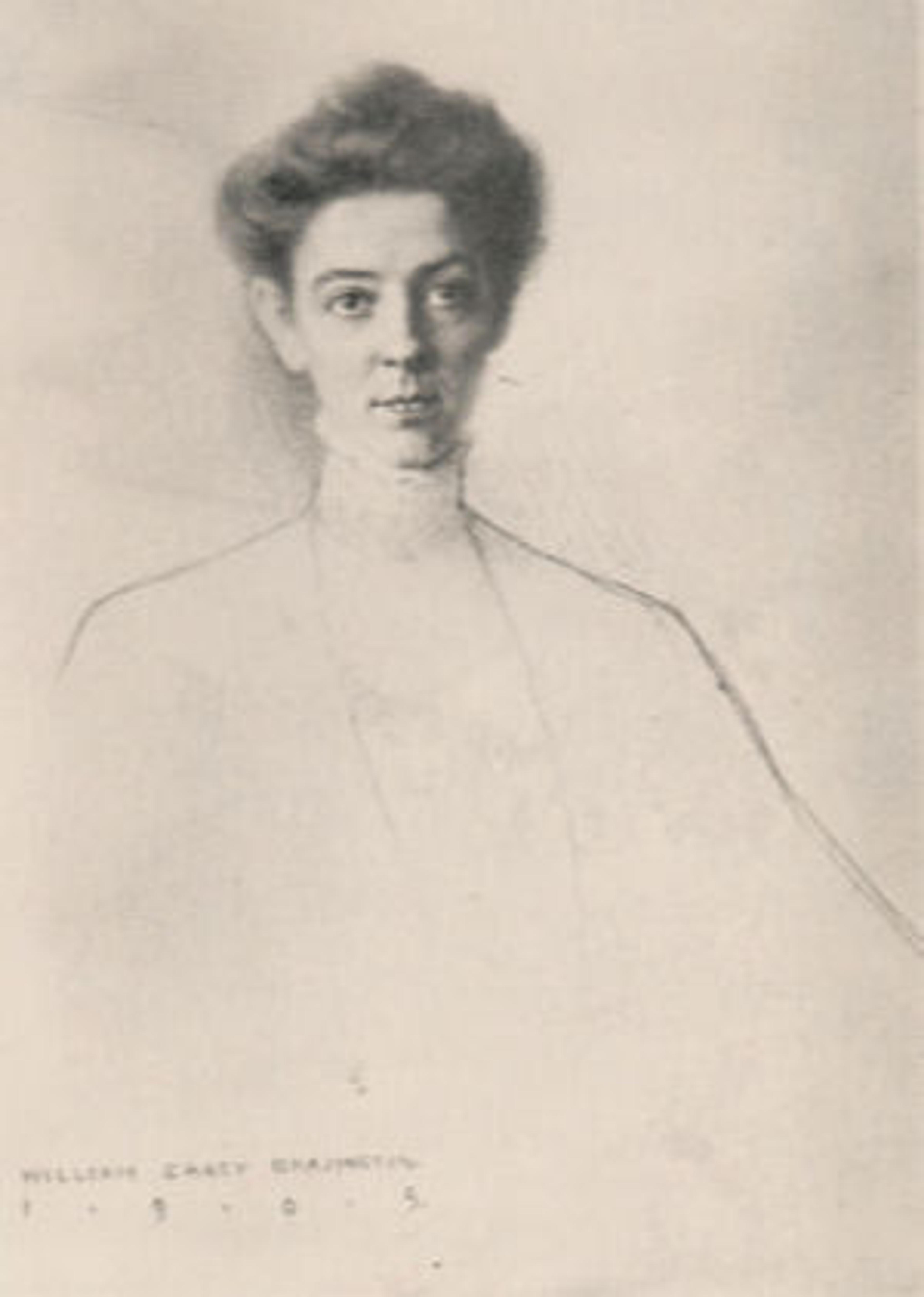
Left: Photograph of a lost 1905 drawing of Frances Morris by William Carey Brazington
Morris began her thirty-three-year career at the Museum in 1896—at first only one day a week, to fill an acute need. The Drexel collection of 44 instruments was given to the Museum in 1884, but in 1889 the collection grew exponentially with the arrival of the first 278 instruments of The Crosby Brown Collection. In 1896, when the collection had grown to 1,200 instruments and the Museum set aside two new galleries solely for them, donor Mary Elizabeth Brown and her husband, Museum Trustee John Crosby Brown, realized that researching, arranging, and cataloguing the collection was going to require an on-site professional. (The Museum's curator of Sculpture, Professor Isaac Hall, under whose supervision the instrument collection fell, was an expert on oriental languages, and not a musicologist.)
When Morris began working at the Museum, she was employed as a full-time assistant to the famous social reformer and Presbyterian clergyman Dr. Charles Parkhurst and freelanced in her spare time as an assistant to Mary Elizabeth Brown, whose father and son were both Presbyterian clergymen who knew Dr. Parkhurst. So when the need for an on-site presence at the Museum became apparent, the Browns looked no further than Morris. Mary Elizabeth Brown wrote to Museum Director Luigi Cesnola shortly afterwards, saying: "I am sure Miss Morris is doing most intelligent faithful work. Mr. Brown often says he wishes he could have [Morris] in his office for he has never worked with a woman who had so good a business head."
There were only a few other women employees, and none was a professional; they worked in the ladies' cloakrooms and in the new restaurant. After Morris arrived, however, the Museum hired a handful of women professionals—there were nine by 1906—and Morris's office on the top floor became their unofficial lounge. Morris sent the bills for her time working at the Museum—one day a week, expanded to two days a week in 1898—to Cesnola for payment. Initially, her salary of one dollar per hour was underwritten by the Browns, hence she does not appear on the Museum's direct payroll until 1902. In 1898, Brown informed Cesnola that Morris should be hired full time by the Museum.
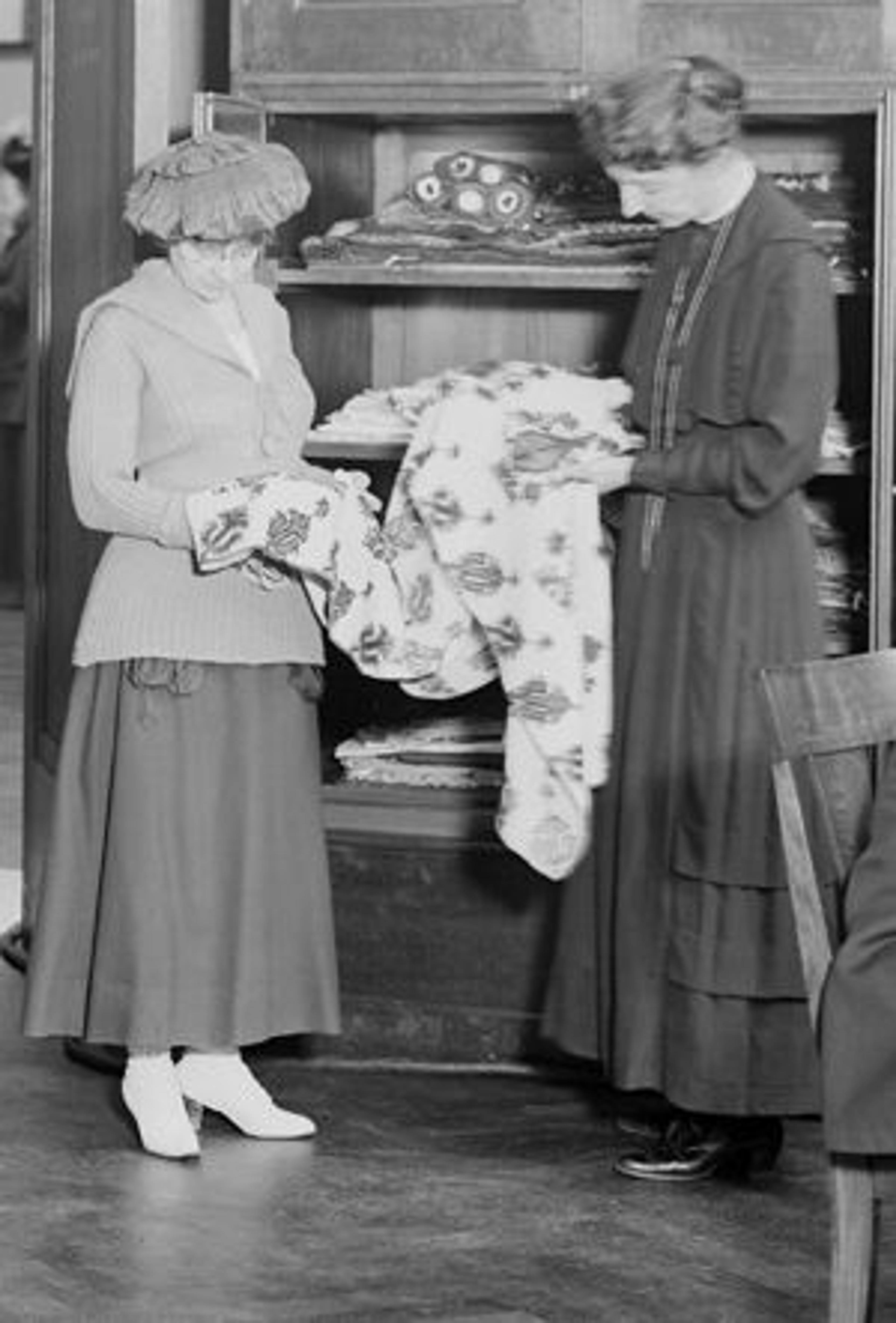
Left: Frances Morris (right) in the Textile Study Room with a Museum patron, 1918
By October 1905, Museum records show that Morris was employed as "Assistant, Department of Musical Instruments," at an annual salary "not to exceed" $1,200. Her duties included the collection of musical instruments and, by 1907, the Museum's textile and lace collections. Perhaps because of her gender, other duties also fell upon her: for example, decorating the Director's office for Christmas.
When Morris started at the Museum, a curator led each of the three departments—Painting, Sculpture, and Plaster Casts. The Musical instruments collection at first was formally classified as Sculpture, but later transferred to the newly created Department of Decorative Arts in 1907. However, by 1905 the Museum had begun treating the Musical Instrument collection as a separate department: Morris corresponded on behalf of the Museum on letterhead titled "Department of Musical Instruments, The Crosby Brown Collection," and she signed correspondence, even with Museum trustees, "F. Morris, curator." Morris herself formally obtained a curatorial title, assistant curator, in 1910 (and was promoted in 1921 to associate curator in charge of Textiles). In 1914 the New York Times described her as "the needlework expert of the Museum" and the "curator of the [Musical Instruments] department [who] arranged the permanent collection exhibit."
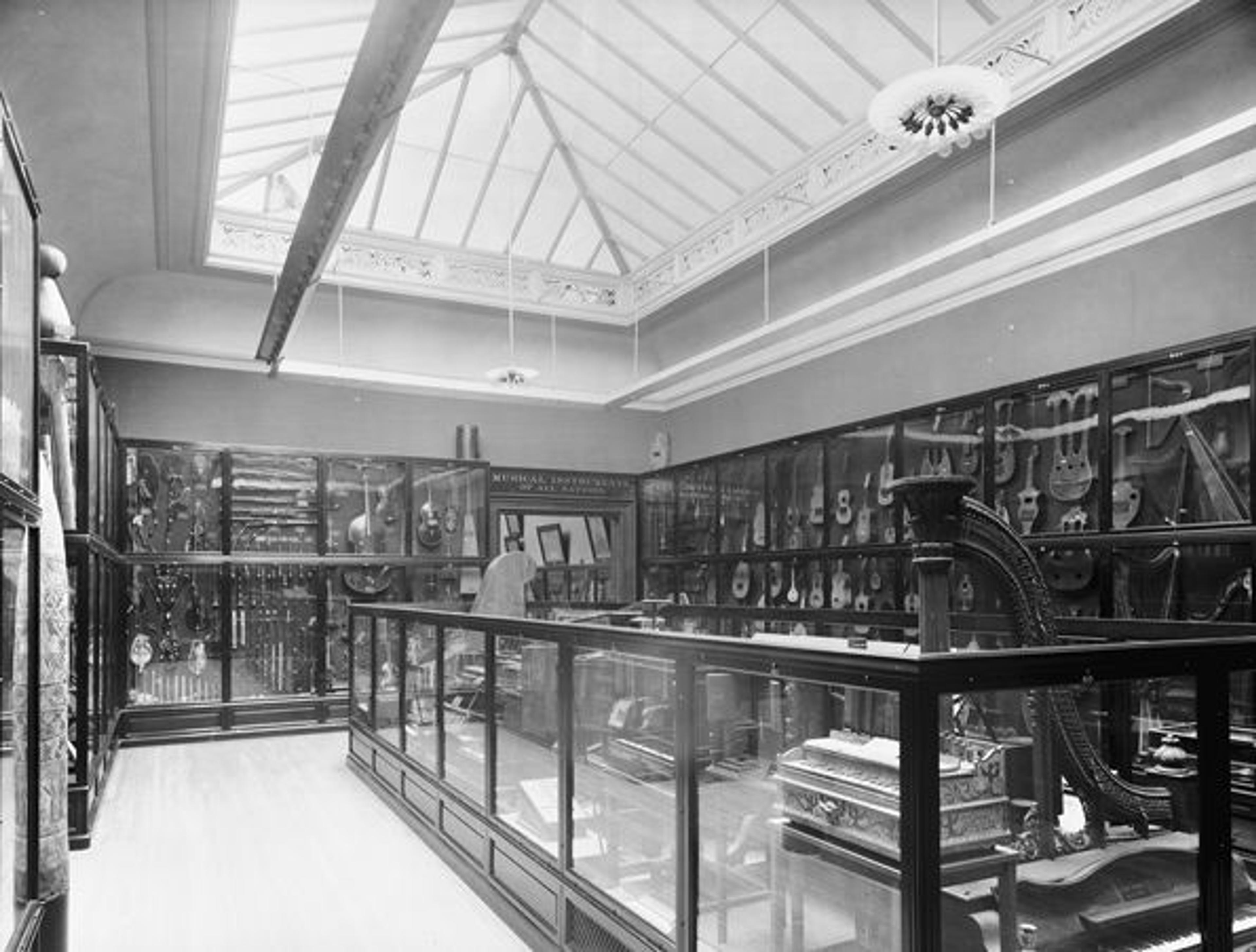
Second-floor Musical Instruments galleries of Wing C, photographed May 1907
For the whole of her thirty-three years at the Museum, Morris handled all aspects of the daily operations of the musical instruments collection, and much of the correspondence. Mary Elizabeth Brown shaped the collection by deciding what to acquire, and the Browns remained interested and involved in various aspects of the collection until John Crosby Brown's death in 1909, but it was Morris who ensured that descriptions and labels of exotic, little-known instruments were correct, catalogue organizations made sense, and illustrations and models were accurate. If banana stalks were supposed to be used to support an African instrument, then Morris got banana stalks from the New York Botanical Garden; if cataloguing the Native American instruments meant developing a whole encyclopedia of languages and tribes, Morris developed one so good that the Smithsonian's curator of Native American objects encouraged her to publish it; and when the identity of an object was uncertain, she inquired with the Natural History Museum about whether it was a flute, whistle, or club.
Morris traveled to see other collections in the United States and abroad, arranged for repairs, and oversaw the publication of the many volumes of the collection's catalogues between 1901 and 1914—a Herculean task involving correspondence with other experts worldwide. She mounted temporary loan exhibitions in the Musical Instrument galleries: for example, in 1920, of musical manuscripts and incunabula, and in 1928, for the Schubert Centennial.
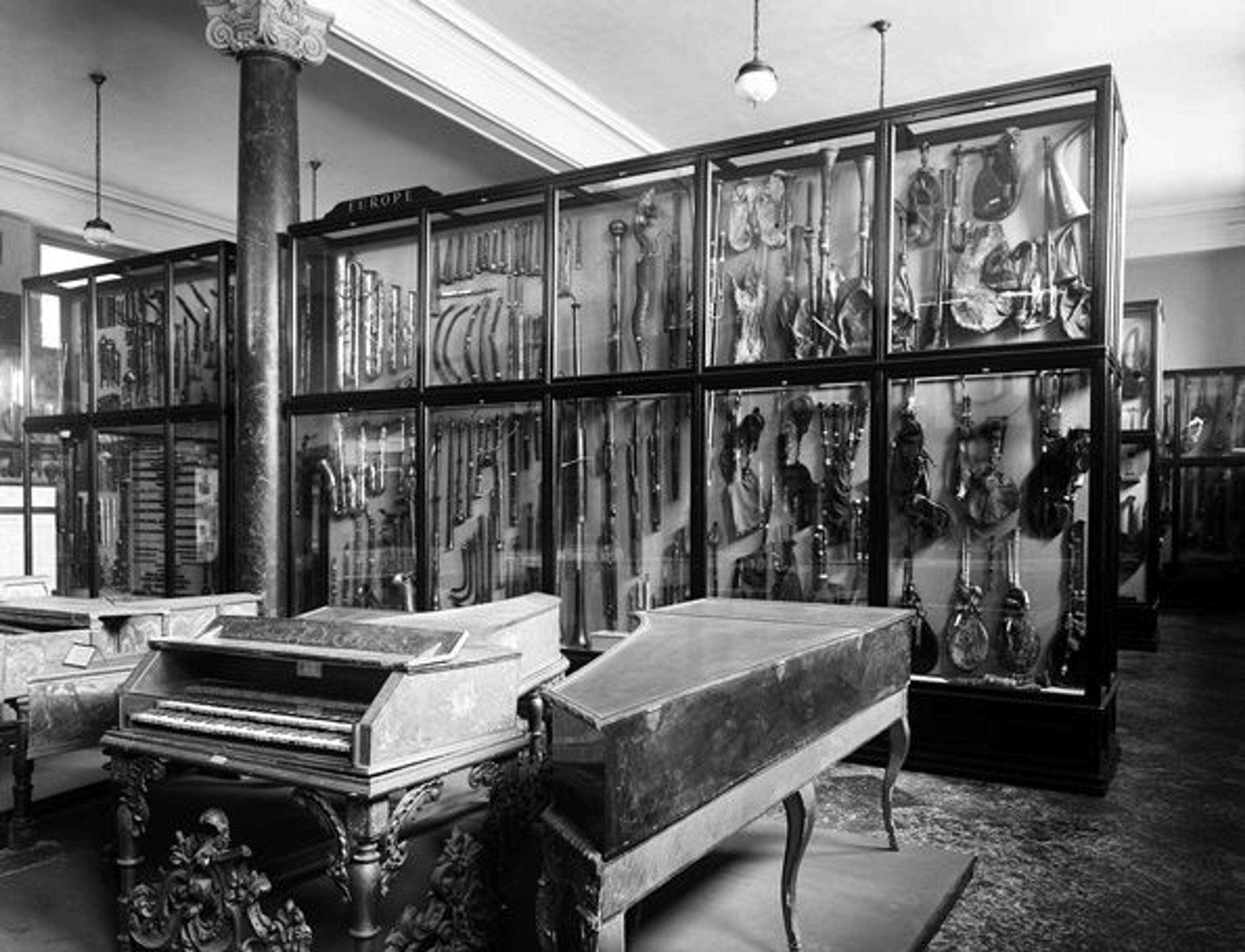
First-floor Musical Instrument galleries as Morris arranged them, photographed 1914
The public face of the collection, Morris was the one who gave lectures and tours both inside and outside the Museum. Never afraid of innovation, she gave a number of pioneering lectures for the blind, and when radio became part of the Museum's outreach in January 1926, she gave the second broadcast ever made from the Museum, "The Instruments of the Orchestra." She bid at auction for the Museum and published articles about the instruments. It is clear in both her writing and lectures that Morris's understanding of musicianship was sophisticated, though the only instrument she herself is recorded as playing is the kettledrum.
In 1907 the Museum director also placed Morris in charge of the Museum's textiles; she became the official "Keeper" of the Museum's lace and textile study room when it opened in 1910, and by 1923 it held more than twelve thousand pieces. She became a respected textile scholar and wrote numerous scholarly articles on lace, textiles, and carpets. While she remained in charge of the musical instruments for her entire time at the Museum, from about 1910 on she spent a larger portion of her time—and published almost exclusively—on textiles rather than instruments, although she continued to lecture extensively on instruments. Though self-taught in both fields as far as is known, she became knowledgeable and respected in both the textile and musical instrument fields. Morris traveled domestically and abroad to further her expertise, and was an unusual and accomplished figure in the almost exclusively male museum world of the 1910s and '20s.
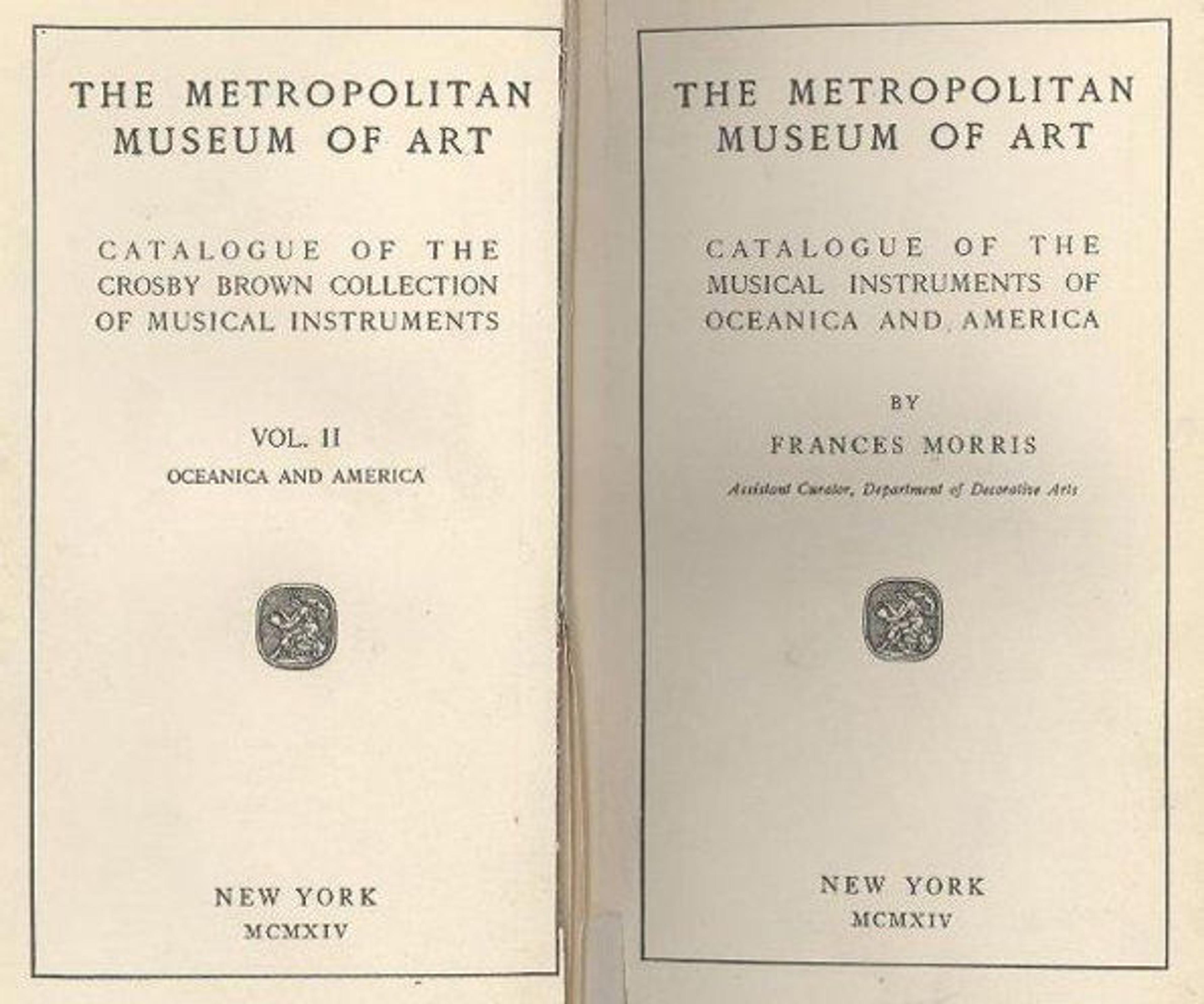
Frontispiece of the Catalogue of The Crosby Brown Collection of Musical Instruments, Volume II: Oceania and America, published by Morris in 1914
Morris resigned from the Museum in 1929, at the age of 64. The immediate cause was a decision to undertake a protracted trip around the world, but her departure came after several months of negotiations, during which she had informed the Museum that they needed to give her a raise, an assistant, a leave of absence, and promotion to full curator. She got the raise, from $5,500 to $6,000 per year ($6,000 was the maximum allowed under Museum regulations for any associate curator), but not the promotion.
After her resignation, the Museum had no staff with any knowledge of the instruments, and the collection suffered as a result. Though Morris remained on good terms with the Museum and continued to make donations—in all she donated forty-five accessioned objects, mostly textiles, as well as a grand piano—she never again did any work on the collections. In 1942 she wrote to the new director, Francis Taylor, "is it going to be possible to salvage some of the musical instruments, and could I in any way help—I'd love to." Taylor responded that he "hopes in the near future that it may be possible for us to do something more with the musical instruments," but there is no record that Morris was ever in touch with her successor, curator Emanuel Winternitz, who arrived that year. Morris died in 1955.
Related Links
Of Note: Mary Elizabeth Adams Brown's Collection Celebrates 125 Years at the Met
Of Note: Joseph W. Drexel and the Beginnings of the Met's Musical Instrument Collection